Unit 6 At one with nature Listening and Speaking课件(共24张,内嵌音频)
文档属性
| 名称 | Unit 6 At one with nature Listening and Speaking课件(共24张,内嵌音频) |
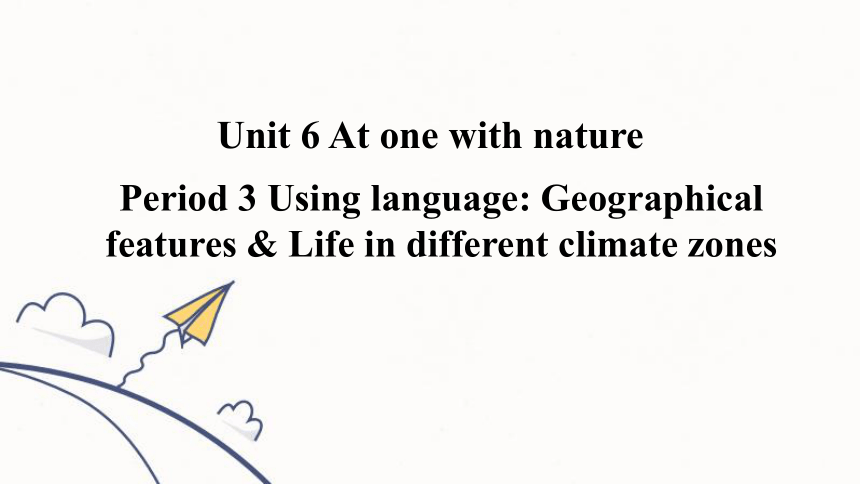
|
|
| 格式 | pptx | ||
| 文件大小 | 28.8MB | ||
| 资源类型 | 教案 | ||
| 版本资源 | 外研版(2019) | ||
| 科目 | 英语 | ||
| 更新时间 | 2024-10-19 15:34:17 | ||
图片预览

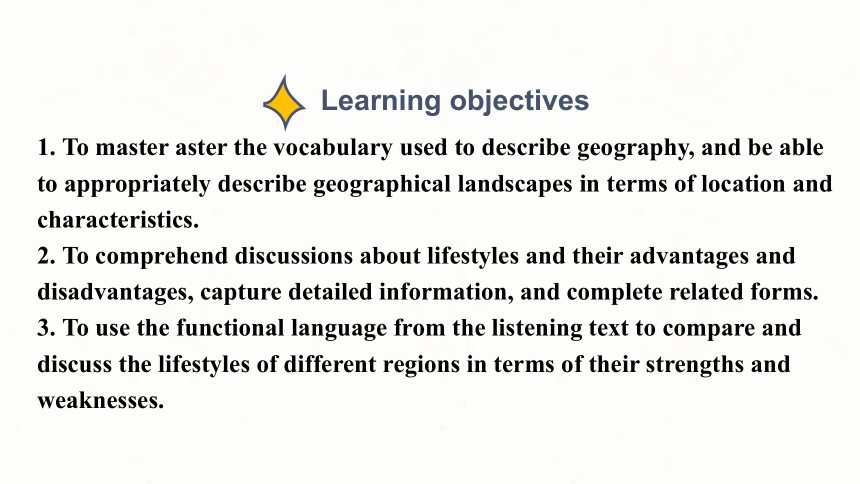
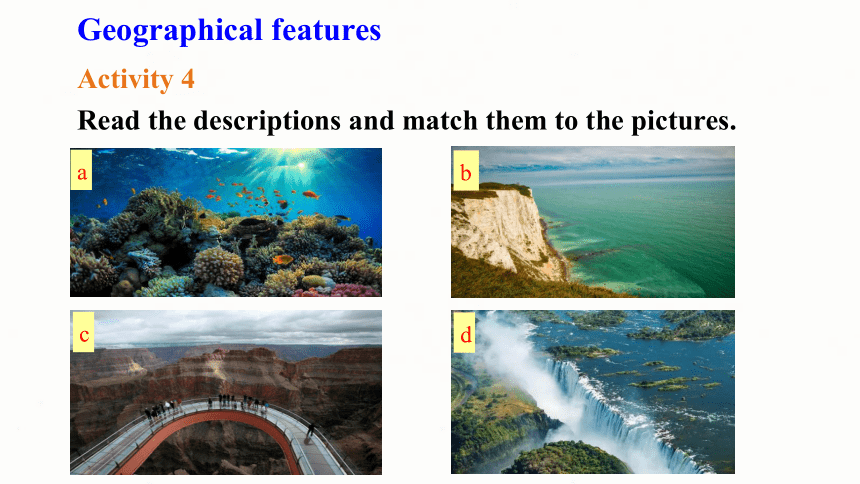
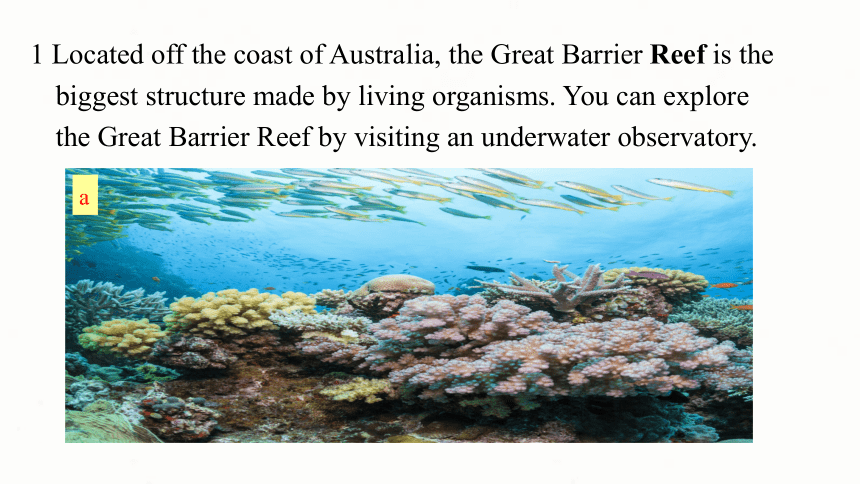
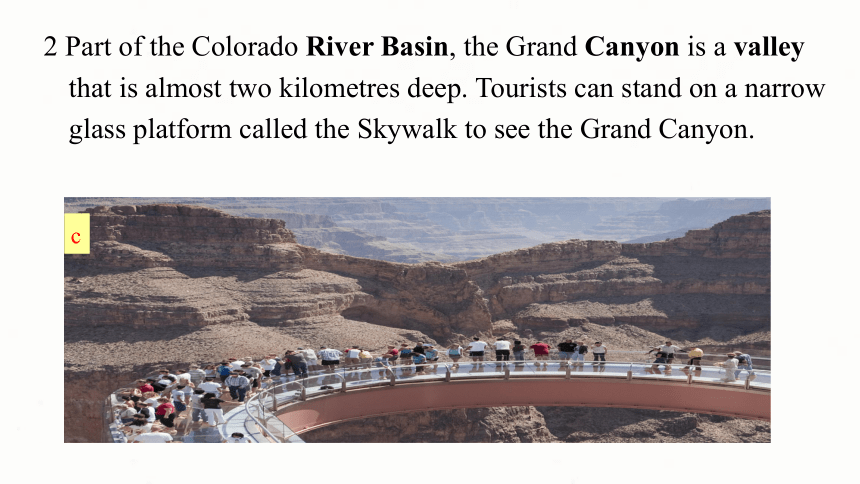
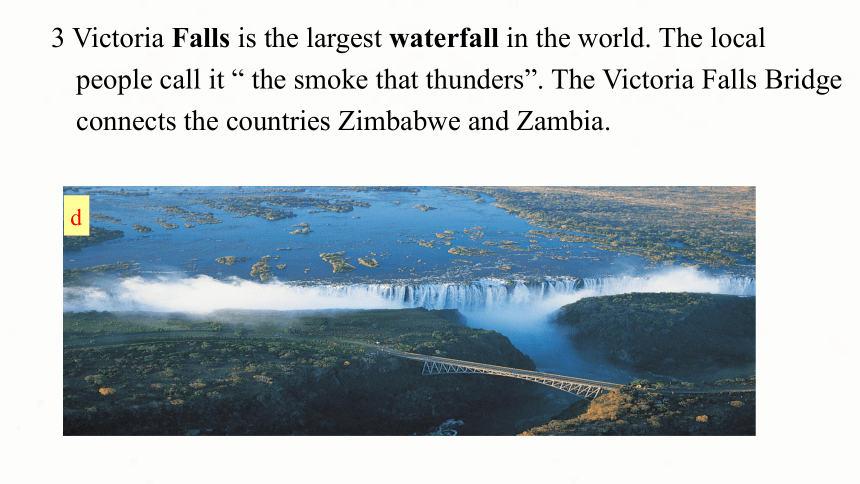
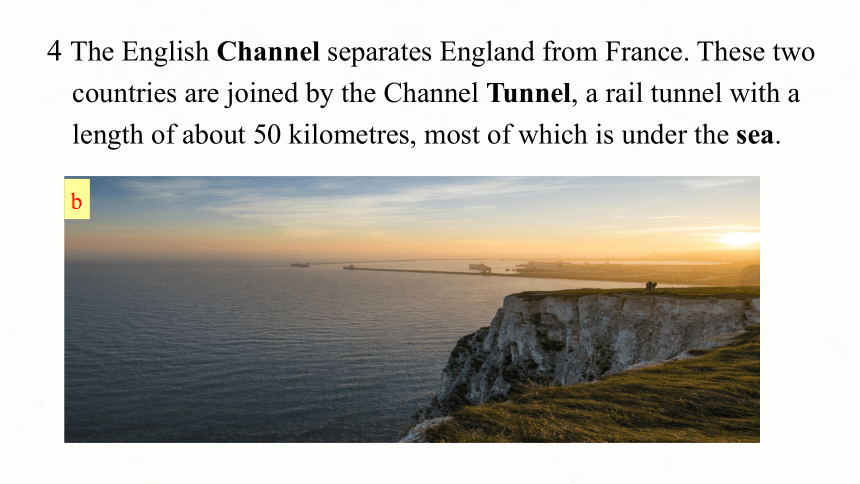
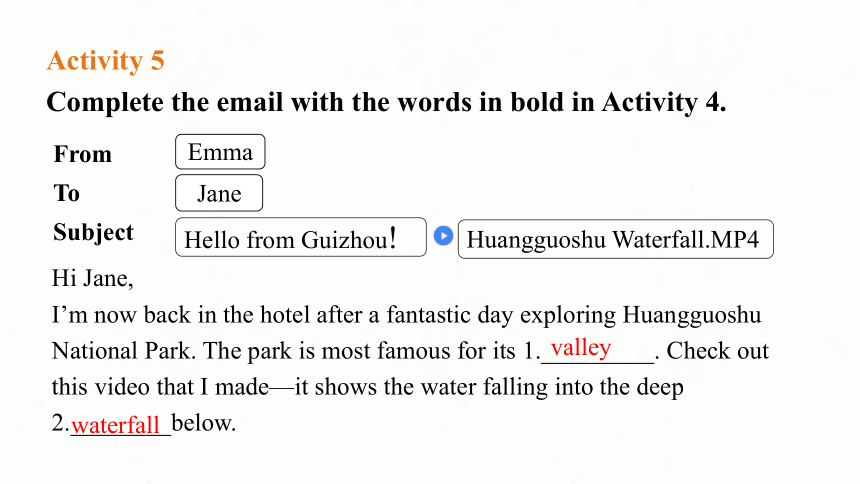
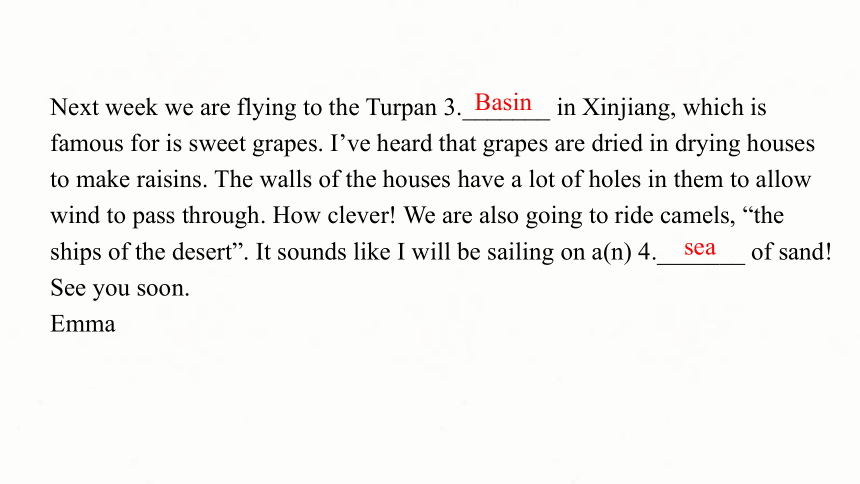
文档简介
(共24张PPT)
Unit 6 At one with nature
Period 3 Using language: Geographical features & Life in different climate zones
1. To master aster the vocabulary used to describe geography, and be able to appropriately describe geographical landscapes in terms of location and characteristics.
2. To comprehend discussions about lifestyles and their advantages and disadvantages, capture detailed information, and complete related forms.
3. To use the functional language from the listening text to compare and discuss the lifestyles of different regions in terms of their strengths and weaknesses.
Learning objectives
Activity 4
Read the descriptions and match them to the pictures.
a
b
c
d
Geographical features
1 Located off the coast of Australia, the Great Barrier Reef is the biggest structure made by living organisms. You can explore the Great Barrier Reef by visiting an underwater observatory.
a
2 Part of the Colorado River Basin, the Grand Canyon is a valley that is almost two kilometres deep. Tourists can stand on a narrow glass platform called the Skywalk to see the Grand Canyon.
c
3 Victoria Falls is the largest waterfall in the world. The local people call it “ the smoke that thunders”. The Victoria Falls Bridge connects the countries Zimbabwe and Zambia.
d
4 The English Channel separates England from France. These two countries are joined by the Channel Tunnel, a rail tunnel with a length of about 50 kilometres, most of which is under the sea.
b
Hi Jane,
I’m now back in the hotel after a fantastic day exploring Huangguoshu National Park. The park is most famous for its 1._________. Check out this video that I made—it shows the water falling into the deep 2.________below.
Activity 5
Complete the email with the words in bold in Activity 4.
waterfall
valley
Emma
Jane
Hello from Guizhou!
From
To
Subject
Huangguoshu Waterfall.MP4
Next week we are flying to the Turpan 3._______ in Xinjiang, which is famous for is sweet grapes. I’ve heard that grapes are dried in drying houses to make raisins. The walls of the houses have a lot of holes in them to allow wind to pass through. How clever! We are also going to ride camels, “the ships of the desert”. It sounds like I will be sailing on a(n) 4._______ of sand!
See you soon.
Emma
Basin
sea
Activity 6
Work in pairs. Talk about other geographical features in the world.
Life in different climate zones
Where can we see the glacier in the world
Around four million people live in the Arctic region, of whom around 170,000 are Inuit.
In the Arctic, the temperature can reach as low as -70 C.
The Arctic includes parts of eight countries: Canada, Russia, the United States, Denmark, Norway, Iceland, Sweden and Finland.
Did you know
Activity 7
Listen to a girl talking about Inuit life and identify the things that are mentioned.
When you hear a word that you don’t recognise, don’t panic! Try to note down how it sounds, and keep listening. When you have finished listening, try to work out the meaning from the context of the word.
Learning to learn
Inuit life Advantages Disadvantages
Housing Igloos are quite warm inside and it’s easy to find the______________.
Igloos can only _______ for around 50 days.
Food Eating a lot of fish and meat keeps our bodies strong so that we can _____________. The ___________ makes it difficult for us to grow enough vegetables and fruit.
cold weather
building materials
be kept
fight the cold
Activity 8
Listen again and complete the table.
Inuit life Advantages Disadvantages
Polar night It gives us more _______ to be with our family and friends. Life can be _________ sometimes.
Tourism It brings more money and ______________. Our environment is being____________.
time
boring
job opportunities
polluted
This can only be a good / bad thing.
The upside / downside to this is…
The advantage / disadvantage is …
There are pros and cons to this.
Another positive / negative aspect is…
Best / Worst of all, …
Useful expressions
Activity 9
Work in pairs. Talk about life in the tropics and the Arctic.
Student A: Turn to Page 83.
Student B: Turn to Page 86.
tropics
Student A
You live in the tropics. Talk about your life with Student B from the Arctic.
Disadvantages of living in the tropics:
It can get too hot to go outside.
There are tropical storms.
Food can go bad quickly.
Advantages of living in the tropics:
It’s usually warm all year round.
It’s easy to grow food.
The jungles are full of beautiful plants and animals.
Arctic
Student B
You live in the Arctic. Talk about your life with Student A from the tropics.
Disadvantages of living in the Arctic:
It gets very cold and is dark during much of the year.
Fruit and vegetables don’t grow naturally.
Life can sometimes be boring and dull.
Advantages of living in the Arctic:
The Northern Lights are amazing.
Food can be preserved for a long time.
It’s not too crowded.
1. Based on what we learnt today, finish Activity 10 on Page 67.
2. Collect materials about British gardening online.
Then finish the quiz on Page 68.
Homework
Unit 6 At one with nature
Period 3 Using language: Geographical features & Life in different climate zones
1. To master aster the vocabulary used to describe geography, and be able to appropriately describe geographical landscapes in terms of location and characteristics.
2. To comprehend discussions about lifestyles and their advantages and disadvantages, capture detailed information, and complete related forms.
3. To use the functional language from the listening text to compare and discuss the lifestyles of different regions in terms of their strengths and weaknesses.
Learning objectives
Activity 4
Read the descriptions and match them to the pictures.
a
b
c
d
Geographical features
1 Located off the coast of Australia, the Great Barrier Reef is the biggest structure made by living organisms. You can explore the Great Barrier Reef by visiting an underwater observatory.
a
2 Part of the Colorado River Basin, the Grand Canyon is a valley that is almost two kilometres deep. Tourists can stand on a narrow glass platform called the Skywalk to see the Grand Canyon.
c
3 Victoria Falls is the largest waterfall in the world. The local people call it “ the smoke that thunders”. The Victoria Falls Bridge connects the countries Zimbabwe and Zambia.
d
4 The English Channel separates England from France. These two countries are joined by the Channel Tunnel, a rail tunnel with a length of about 50 kilometres, most of which is under the sea.
b
Hi Jane,
I’m now back in the hotel after a fantastic day exploring Huangguoshu National Park. The park is most famous for its 1._________. Check out this video that I made—it shows the water falling into the deep 2.________below.
Activity 5
Complete the email with the words in bold in Activity 4.
waterfall
valley
Emma
Jane
Hello from Guizhou!
From
To
Subject
Huangguoshu Waterfall.MP4
Next week we are flying to the Turpan 3._______ in Xinjiang, which is famous for is sweet grapes. I’ve heard that grapes are dried in drying houses to make raisins. The walls of the houses have a lot of holes in them to allow wind to pass through. How clever! We are also going to ride camels, “the ships of the desert”. It sounds like I will be sailing on a(n) 4._______ of sand!
See you soon.
Emma
Basin
sea
Activity 6
Work in pairs. Talk about other geographical features in the world.
Life in different climate zones
Where can we see the glacier in the world
Around four million people live in the Arctic region, of whom around 170,000 are Inuit.
In the Arctic, the temperature can reach as low as -70 C.
The Arctic includes parts of eight countries: Canada, Russia, the United States, Denmark, Norway, Iceland, Sweden and Finland.
Did you know
Activity 7
Listen to a girl talking about Inuit life and identify the things that are mentioned.
When you hear a word that you don’t recognise, don’t panic! Try to note down how it sounds, and keep listening. When you have finished listening, try to work out the meaning from the context of the word.
Learning to learn
Inuit life Advantages Disadvantages
Housing Igloos are quite warm inside and it’s easy to find the______________.
Igloos can only _______ for around 50 days.
Food Eating a lot of fish and meat keeps our bodies strong so that we can _____________. The ___________ makes it difficult for us to grow enough vegetables and fruit.
cold weather
building materials
be kept
fight the cold
Activity 8
Listen again and complete the table.
Inuit life Advantages Disadvantages
Polar night It gives us more _______ to be with our family and friends. Life can be _________ sometimes.
Tourism It brings more money and ______________. Our environment is being____________.
time
boring
job opportunities
polluted
This can only be a good / bad thing.
The upside / downside to this is…
The advantage / disadvantage is …
There are pros and cons to this.
Another positive / negative aspect is…
Best / Worst of all, …
Useful expressions
Activity 9
Work in pairs. Talk about life in the tropics and the Arctic.
Student A: Turn to Page 83.
Student B: Turn to Page 86.
tropics
Student A
You live in the tropics. Talk about your life with Student B from the Arctic.
Disadvantages of living in the tropics:
It can get too hot to go outside.
There are tropical storms.
Food can go bad quickly.
Advantages of living in the tropics:
It’s usually warm all year round.
It’s easy to grow food.
The jungles are full of beautiful plants and animals.
Arctic
Student B
You live in the Arctic. Talk about your life with Student A from the tropics.
Disadvantages of living in the Arctic:
It gets very cold and is dark during much of the year.
Fruit and vegetables don’t grow naturally.
Life can sometimes be boring and dull.
Advantages of living in the Arctic:
The Northern Lights are amazing.
Food can be preserved for a long time.
It’s not too crowded.
1. Based on what we learnt today, finish Activity 10 on Page 67.
2. Collect materials about British gardening online.
Then finish the quiz on Page 68.
Homework
